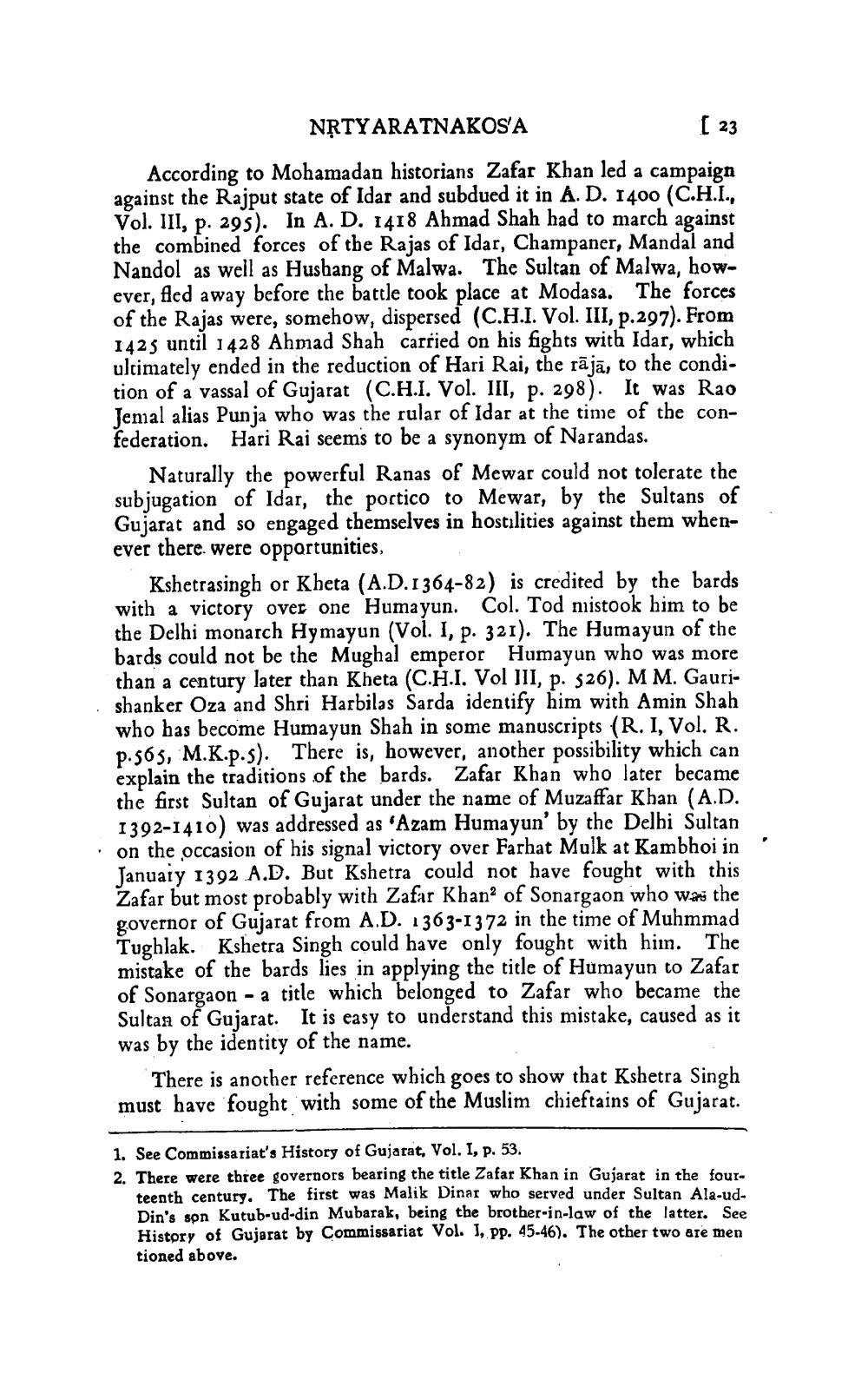________________
NRTYARATNAKOS'A
[23
According to Mohamadan historians Zafar Khan led a campaign against the Rajput state of Idar and subdued it in A. D. 1400 (C.H.I., Vol. III, p. 295). In A. D. 1418 Ahmad Shah had to march against the combined forces of the Rajas of Idar, Champaner, Mandal and Nandol as well as Hushang of Malwa. The Sultan of Malwa, however, fled away before the battle took place at Modasa. The forces of the Rajas were, somehow, dispersed (C.H.I. Vol. III, p.297). From 1425 until 1428 Ahmad Shah carried on his fights with Idar, which ultimately ended in the reduction of Hari Rai, the raja, to the condition of a vassal of Gujarat (C.H.I. Vol. III, p. 298). It was Rao Jemal alias Punja who was the rular of Idar at the time of the confederation. Hari Rai seems to be a synonym of Narandas.
Naturally the powerful Ranas of Mewar could not tolerate the subjugation of Idar, the portico to Mewar, by the Sultans of Gujarat and so engaged themselves in hostilities against them whenever there were opportunities,
Kshetrasingh or Kheta (A.D.1364-82) is credited by the bards with a victory over one Humayun. Col. Tod mistook him to be the Delhi monarch Hymayun (Vol. I, p. 321). The Humayun of the bards could not be the Mughal emperor Humayun who was more than a century later than Kheta (C.H.I. Vol III, p. 526). M M. Gaurishanker Oza and Shri Harbilas Sarda identify him with Amin Shah who has become Humayun Shah in some manuscripts (R. I, Vol. R. p.565, M.K.p.s). There is, however, another possibility which can explain the traditions of the bards. Zafar Khan who later became the first Sultan of Gujarat under the name of Muzaffar Khan (A.D. 1392-1410) was addressed as 'Azam Humayun' by the Delhi Sultan on the occasion of his signal victory over Farhat Mulk at Kambhoi in January 1392 A.D. But Kshetra could not have fought with this Zafar but most probably with Zafar Khan of Sonargaon who was the governor of Gujarat from A.D. 1363-1372 in the time of Muhmmad Tughlak. Kshetra Singh could have only fought with him. The mistake of the bards lies in applying the title of Humayun to Zafar of Sonargaon a title which belonged to Zafar who became the Sultan of Gujarat. It is easy to understand this mistake, caused as it was by the identity of the name.
-
There is another reference which goes to show that Kshetra Singh must have fought with some of the Muslim chieftains of Gujarat.
1. See Commissariat's History of Gujarat, Vol. I, p. 53.
2. There were three governors bearing the title Zafar Khan in Gujarat in the fourteenth century. The first was Malik Dinar who served under Sultan Ala-udDin's son Kutub-ud-din Mubarak, being the brother-in-law of the latter. See History of Gujarat by Commissariat Vol. I, pp. 45-46). The other two are men tioned above.




